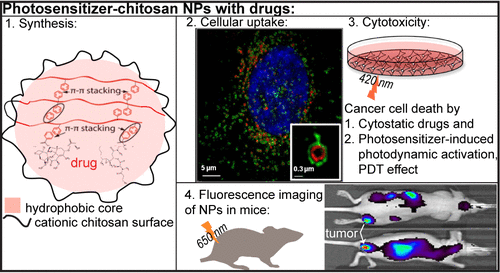当前位置:
X-MOL 学术
›
Biomacromolecules
›
论文详情
Our official English website, www.x-mol.net, welcomes your feedback! (Note: you will need to create a separate account there.)
Drug-Loaded Photosensitizer-Chitosan Nanoparticles for Combinatorial Chemo- and Photodynamic-Therapy of Cancer.
Biomacromolecules ( IF 6.2 ) Pub Date : 2020-02-24 , DOI: 10.1021/acs.biomac.0c00061 Abhilash D Pandya 1 , Anders Øverbye 2 , Priyanka Sahariah 3 , Vivek S Gaware 3 , Håkon Høgset 2 , Màr Masson 3 , Anders Høgset 4 , Gunhild M Mælandsmo 1, 5 , Tore Skotland 2 , Kirsten Sandvig 2, 6 , Tore-Geir Iversen 2
Biomacromolecules ( IF 6.2 ) Pub Date : 2020-02-24 , DOI: 10.1021/acs.biomac.0c00061 Abhilash D Pandya 1 , Anders Øverbye 2 , Priyanka Sahariah 3 , Vivek S Gaware 3 , Håkon Høgset 2 , Màr Masson 3 , Anders Høgset 4 , Gunhild M Mælandsmo 1, 5 , Tore Skotland 2 , Kirsten Sandvig 2, 6 , Tore-Geir Iversen 2
Affiliation

|
In this study we have developed biodegradable polymeric nanoparticles (NPs) containing the cytostatic drugs mertansine (MRT) or cabazitaxel (CBZ). The NPs are based on chitosan (CS) conjugate polymers synthesized with different amounts of the photosensitizer tetraphenylchlorin (TPC). These TPC–CS NPs have high loading capacity and strong drug retention due to π–π stacking interactions between the drugs and the aromatic photosensitizer groups of the polymers. CS polymers with 10% of the side chains containing TPC were found to be optimal in terms of drug loading capacity and NP stability. The TPC–CS NPs loaded with MRT or CBZ displayed higher cytotoxicity than the free form of these drugs in the breast cancer cell lines MDA-MB-231 and MDA-MB-468. Furthermore, light-induced photochemical activation of the NPs elicited a strong photodynamic therapy effect on these breast cancer cells. Biodistribution studies in mice showed that most of the TPC–CS NPs accumulated in liver and lungs, but they were also found to be localized in tumors derived from HCT-116 cells. These data suggest that the drug-loaded TPC–CS NPs have a potential in combinatory anticancer therapy and as contrast agents.
中文翻译:

药物组合的光敏剂-壳聚糖纳米粒子用于癌症的组合化学和光动力疗法。
在这项研究中,我们开发了可生物降解的聚合物纳米颗粒(NPs),其中包含细胞抑制药Mertansine(MRT)或Cabazitaxel(CBZ)。NP是基于壳聚糖(CS)共轭聚合物合成的,该聚合物与不同数量的光敏剂四苯基二氯(TPC)合成。由于药物与聚合物的芳族光敏剂基团之间存在π-π堆积相互作用,因此这些TPC-CS NP具有较高的载药量和较强的药物保留能力。发现在载药量和NP稳定性方面,具有10%含TPC的侧链的CS聚合物是最佳的。在乳腺癌细胞系MDA-MB-231和MDA-MB-468中,载有MRT或CBZ的TPC-CS NPs比这些药物的游离形式具有更高的细胞毒性。此外,NPs的光诱导光化学活化引发了对这些乳腺癌细胞的强大的光动力治疗作用。小鼠的生物分布研究表明,大多数TPC-CS NP积累在肝和肺中,但也发现它们位于HCT-116细胞衍生的肿瘤中。这些数据表明,载药的TPC-CS NP在联合抗癌治疗和作为造影剂方面具有潜力。
更新日期:2020-02-24
中文翻译:

药物组合的光敏剂-壳聚糖纳米粒子用于癌症的组合化学和光动力疗法。
在这项研究中,我们开发了可生物降解的聚合物纳米颗粒(NPs),其中包含细胞抑制药Mertansine(MRT)或Cabazitaxel(CBZ)。NP是基于壳聚糖(CS)共轭聚合物合成的,该聚合物与不同数量的光敏剂四苯基二氯(TPC)合成。由于药物与聚合物的芳族光敏剂基团之间存在π-π堆积相互作用,因此这些TPC-CS NP具有较高的载药量和较强的药物保留能力。发现在载药量和NP稳定性方面,具有10%含TPC的侧链的CS聚合物是最佳的。在乳腺癌细胞系MDA-MB-231和MDA-MB-468中,载有MRT或CBZ的TPC-CS NPs比这些药物的游离形式具有更高的细胞毒性。此外,NPs的光诱导光化学活化引发了对这些乳腺癌细胞的强大的光动力治疗作用。小鼠的生物分布研究表明,大多数TPC-CS NP积累在肝和肺中,但也发现它们位于HCT-116细胞衍生的肿瘤中。这些数据表明,载药的TPC-CS NP在联合抗癌治疗和作为造影剂方面具有潜力。



























 京公网安备 11010802027423号
京公网安备 11010802027423号